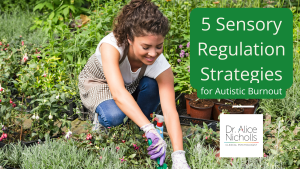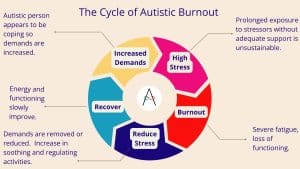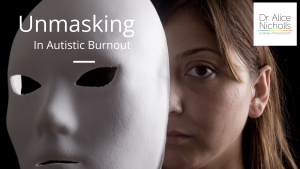Research estimates suggest that between 80-90% of autistic people will have differences in their sensory processing that impact on their daily life and can contribute to Autistic Burnout.
People with these sensory differences can be over responsive, under responsive or seeking of different sensory inputs. There isn’t a specific pattern to this, for example, one autistic person might be highly responsive to auditory stimulation while another might be under responsive.
Both under and over stimulation can cause significant stress.
Research has identified unmet sensory needs as a contributing factor in Autistic Burnout.
Working out precisely what your sensory needs are can feel like an overwhelming task when you are in Autistic Burnout.
Fortunately there are some sensory regulation strategies that are likely to help regardless of your unique sensory profile.
These are often neglected when we think about sensory needs, people are quick to recommend ear defenders but there are other things you can do to regulate your sensory system without specifically targeting the sense that is over/under responsive.
Five ways you can get some sensory regulation, regardless of your sensory profile
- Linear Vestibular input is movement that includes your head in a straight line, not spinning. It is regulating and organising.
- Deep pressure can be very helpful, although it is tactile, this is still very helpful for people who are over responsive to tactile stimulation.
- Proprioceptive input is calming and organising. You can’t have too much proprioceptive input from a sensory perspective and there are not ‘over responders’ to proprioceptive input.
- Oral motor stimulation is a combination of both proprioception and tactile, it can also be gustatory but it is highly regulating while you are doing it. the effects don’t last but while you are doing it it can be both calming and alerting and can aid in concentration.
- Retreat, is the idea of having somewhere you can go where you can take a break from overstimulating sensory input. so if over- responding is part of your profile it’s likely to be really helpful.
A really good starting point is to add some of these (any that you find appealing) activities into your days and weeks.
I will go through each type of strategy in more detail below. It might help to make a list of the activities you think would suit you.
You can use this list of activities as you plan your days and week, to include regular sensory regulation strategies.
A note of caution applies here, if you find any of these activities make you feel fatigued or unwell please discontinue them.
Linear Vestibular
Any activity in which your head changes position is likely to give you vestibular input.
Here’s a list of some ideas, you can also google ‘linear vestibular input’ to find more:
- Walking or running
- Jumping on a trampoline or trampette
- Bouncing on a gym ball
- Swinging on a swing
- Rocking chair
- Swaying side to side
- Yoga/ Martial Arts/ Gymnastics/ Dance
Deep Pressure
Deep pressure is very calming and regulating but is better if it is active rather than passive.
We tend to get used to passive deep pressure quickly and can then find it hard not to have that pressure. It’s ideal for short periods such as during transitions or when paired with proprioceptive activities.
Here’s another list of ideas:
- Weighted blankets/ objects/ (short term)
- Carrying a heavy backpack/toddler
- Compression clothing
- Body socks
- Bear hugs
- Deep tissue massage
- Baths/swimming
- Pushing body against wall
- Squeezing into tight spaces
- Squeezing hands, wrists, fingers
Proprioceptive
Proprioceptive stimulation is the best regulator in the sense that you can’t have too much from a sensory perspective and it is very calming and regulating.
I would like to issue a word of caution here though, because if you are someone who gets physically fatigued you don’t want to over do these activities and you might want to use the lower energy items on this list.:
- Weight training
- Any physical exercise
- Yoga, Pilates, Martial Arts
- Squeezing a stress ball
- Pushing or pulling activities
- Craft activities
- Clay/ Playdough/ Slime
- Lego
- Housework/ cleaning/ laundry/ cooking
Oral Motor
Oral motor stimulation is really regulating from a proprioceptive, tactile and gustatory perspective. but it is short lived. It’s worth adding this in during times you struggle to regulate:
- Eating crunchy foods – carrot sticks, apples, breadsticks
- Chosing chewier food – e.g. sourdough or bagels
- Chewing gum/ toffees
- Sucking water from a bottle with high resistence
- Chewlry
- Boiled sweets
Retreat
If you get over stimulated it can be really helpful to find ways during your day or week to take a break from that stimulation.
What that looks like depends on your sensory needs.
You can create a space at home or at work that is calming and relaxing. You could include some sensory stimulation that you find soothing, e.g. nice smells, music, a rocking chair or hammock.
If you are at a busy social event you might try and identify a quiet room you can sit in, or go outside, or if there aren’t other options go to the bathroom.
If you use a car you might chose to take a break to go and sit in your car for a few minutes or say you’ve forgotten something and need to pop out to the shop.
There seems to be research evidence that autistic people find being outside less stimulating than being inside, I suspect this depends on what the outside looks like where you are, but if there is a garden or a green space near by this might act as a retreat.
- Taking a break
- Having a soothing, low stimulation area at home/work
- Identifying quiet rooms during busy social events
- Going outside- garden, shed, walk dog
- Sensory deprivation tank
- Noise cancelling headphones/ ear plugs
- Car
- Bathroom
Using these strategies
Try to think of things you can do every day or week and be specific about when you will do them.
Try to include something from each of the five strategies listed in this article.
Please choose activities that you think you might actually enjoy. This is an act of kindness to yourself, not a punishment.
If you really don’t like one of the strategies then don’t use it.
If you are adding in new strategies then please don’t feel you are committing yourself to using them if they don’t work for you. You can revisit and refine your choices as you learn more about yourself.
If you would like to learn more about your specific sensory needs please take a look at my short course on understanding and meeting your sensory needs:











